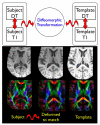Multivariate analysis of structural and diffusion imaging in traumatic brain injury
- PMID: 18995188
- PMCID: PMC6372292
- DOI: 10.1016/j.acra.2008.07.007
Multivariate analysis of structural and diffusion imaging in traumatic brain injury
Abstract
Rationale and objectives: Diffusion tensor (DT) and T1 structural magnetic resonance images provide unique and complementary tools for quantifying the living brain. We leverage both modalities in a diffeomorphic normalization method that unifies analysis of clinical datasets in a consistent and inherently multivariate (MV) statistical framework. We use this technique to study MV effects of traumatic brain injury (TBI).
Materials and methods: We contrast T1 and DT image-based measurements in the thalamus and hippocampus of 12 TBI survivors and nine matched controls normalized to a combined DT and T1 template space. The normalization method uses maps that are topology-preserving and unbiased. Normalization is based on the full tensor of information at each voxel and, simultaneously, the similarity between high-resolution features derived from T1 data. The technique is termed symmetric normalization for MV neuroanatomy (SyNMN). Voxel-wise MV statistics on the local volume and mean diffusion are assessed with Hotelling's T(2) test with correction for multiple comparisons.
Results: TBI significantly (false discovery rate P < .05) reduces volume and increases mean diffusion at coincident locations in the mediodorsal thalamus and anterior hippocampus.
Conclusions: SyNMN reveals evidence that TBI compromises the limbic system. This TBI morphometry study and an additional performance evaluation contrasting SyNMN with other methods suggest that the DT component may aid normalization quality.
Figures









References
-
- Furlow Bryant. Diagnostic imaging of traumatic brain injury. Radiol Technol. 2006;78:145–56. quiz 157-9. - PubMed
-
- Hoge Charles W, McGurk Dennis, Thomas Jeffrey L, Cox Anthony L, Engel Charles C, Castro Carl A. Mild traumatic brain injury in U.S. Soldiers returning from Iraq. N Engl J Med. 2008;358:453–463. - PubMed
-
- Kraus Marilyn F, Susmaras Teresa, Caughlin Benjamin P, Walker Corey J, Sweeney John A, Little Deborah M. White matter integrity and cognition in chronic traumatic brain injury: a diffusion tensor imaging study. Brain. 2007;130:2508–2519. - PubMed
-
- Mendez Cecilia V, Hurley Robin A, Lassonde Maryse, Zhang Liying, Taber Katherine H. Mild traumatic brain injury: neuroimaging of sports-related concussion. J Neuropsychiatry Clin Neurosci. 2005;17:297–303. - PubMed
-
- Chen Jen-Kai, Johnston Karen M, Petrides Michael, Ptito Alain. Neural substrates of symptoms of depression following concussion in male athletes with persisting postconcussion symptoms. Arch Gen Psychiatry. 2008;65:81–89. - PubMed
Publication types
MeSH terms
Grants and funding
LinkOut - more resources
Full Text Sources

